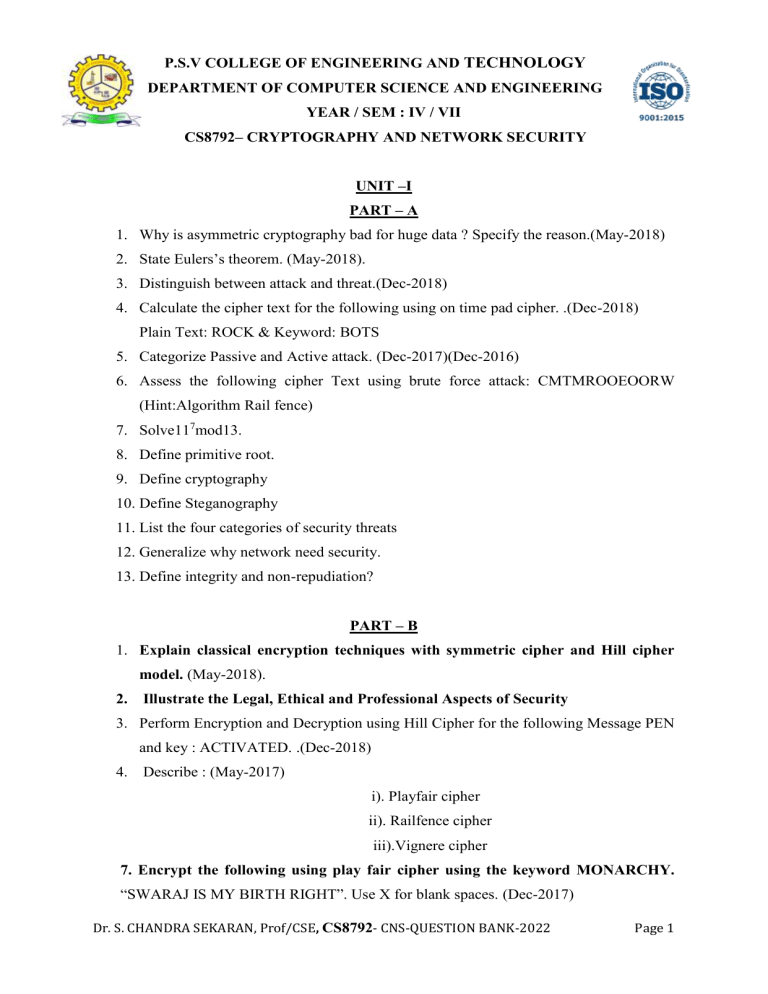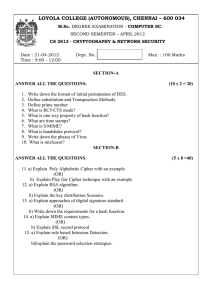
P.S.V COLLEGE OF ENGINEERING AND TECHNOLOGY DEPARTMENT OF COMPUTER SCIENCE AND ENGINEERING YEAR / SEM : IV / VII CS8792– CRYPTOGRAPHY AND NETWORK SECURITY UNIT –I PART – A 1. Why is asymmetric cryptography bad for huge data ? Specify the reason.(May-2018) 2. State Eulers’s theorem. (May-2018). 3. Distinguish between attack and threat.(Dec-2018) 4. Calculate the cipher text for the following using on time pad cipher. .(Dec-2018) Plain Text: ROCK & Keyword: BOTS 5. Categorize Passive and Active attack. (Dec-2017)(Dec-2016) 6. Assess the following cipher Text using brute force attack: CMTMROOEOORW (Hint:Algorithm Rail fence) 7. Solve117mod13. 8. Define primitive root. 9. Define cryptography 10. Define Steganography 11. List the four categories of security threats 12. Generalize why network need security. 13. Define integrity and non-repudiation? PART – B 1. Explain classical encryption techniques with symmetric cipher and Hill cipher model. (May-2018). 2. Illustrate the Legal, Ethical and Professional Aspects of Security 3. Perform Encryption and Decryption using Hill Cipher for the following Message PEN and key : ACTIVATED. .(Dec-2018) 4. Describe : (May-2017) i). Playfair cipher ii). Railfence cipher iii).Vignere cipher 7. Encrypt the following using play fair cipher using the keyword MONARCHY. “SWARAJ IS MY BIRTH RIGHT”. Use X for blank spaces. (Dec-2017) Dr. S. CHANDRA SEKARAN, Prof/CSE, CS8792- CNS-QUESTION BANK-2022 Page 1 8. Explain OSI Security Architecture model with neat diagram (8) (Dec-2016) 10. Describe the various security mechanisms.(8) (Dec-2016) 11. Encrypt the message “PAY” using hill cipher with the following key matrix and show the decryption to formulate original plaintext(8) K= 17 17 5 21 18 21 2 2 19 13. Generalize the security services classifications and security mechanisms in detail.(8) UNIT –II PART – A 1. Compare DES and DES.(Dec-2018) 2. State the difference between private key and public key algorithm.(May-2017) 3. Give the five modes of operation of block cipher.(May-2017) 4. Brief the strengths of triple DES. (Dec-2016) 5. What are the design parameter of Feistel cipher Networks. 6. List the parameters (Block size, key size, and No. of rounds) for the three AES versions(May -2018) 7. Why is trap door one way function used?(Dec-2018) 8. Give the significance of hierarchal key control.(Dec-2017) 9. Specify the application of the public key cryptosystem. 10. Determine the gcd(24140,16762) using Eulid’s algorithm.(May-2017) (Dec-2016) PART-B 1. Describe DES algorithm with neat diagram and explain the steps. (May-2018). 2. Solve gcd (98,56) using Extended Euclidean algorithm. Write the algorithm also. .(Dec-2018) 3. For each of the following elements of DES, indicate the comparable element in AES if available. i. XOR of subkey material with the input to the function. ii. f – function. iii. Permutation – p. iv. Swapping of halves of the block. Dr. S. CHANDRA SEKARAN, Prof/CSE, CS8792- CNS-QUESTION BANK-2022 Page 2 4. What do you mean by AES ? Diagrammatically illustrate the structure of AES and describe the steps in AES encryption process with example. (May-2018)(Dec2018) 5. With a neat sketch explain the following cryptosystem. i. Blowfish (6) b. RC5.(6) 6. Discuss the properties that are to be satisfied by Groups, Rings and Fields. (Dec-2017) 7. Explain in detail about Block cipher design principles – Block cipher mode of operation. 8. Describe the key distribution in detail. 9. Summarize the following in detail (i) Modular Exponentiation (8) (ii) Finite fields (8) UNIT –III PART – A 1. Sate Fermat’s theorem. .(May-2017)(Dec-20 2. What is an elliptic curve?(Dec-2016) 3. Define Primality Testing. 4. Give example for Euler’s totient function 5. Define RSA Cryptosystem. 6. Differentiate Symmetric and Asymmetric key ciphers. 7. Define Exponentiation and logarithm 8. Find Euler’s totient (49) 9. Explain RSA algorithm, perform encryption to the system with p=7, q=11, e=17, M=88.(Dec-2016) 10. Is 301 is Prime? PART-B 1. Find the secret key shared between user A and user B using Diffie Hellman algorithm for the following. q=353, α(primitive root)=3, XA=45 and XB=50 (Dec-2016). 2. Users Alice and Bob use the Diffie-Hellman key exchange technique with a common prime q=83 and a primitive root α = 5. a. If Alice has a private key XA=6, what is Alice’s public key YA? b. If Bob has a private key XB=10, What is Bob’s public key YB? Dr. S. CHANDRA SEKARAN, Prof/CSE, CS8792- CNS-QUESTION BANK-2022 Page 3 c. What is the shared secret key? (Dec-2017) 3. With a neat sketch explain the Elliptic curve cryptography with an example.(May-2018) 4. State Chinese Reminder theorem and find X for the given set of congruent equations using CRT (May-2017) (Dec-2016) X=1(mod 5) X=2(mod 7) X=3(mod 9) X=4(mod 11) 5. State and prove the Chinese remainder theorem. What are the last two digits of 4919? (May-2018). 6. State and prove Fermat’s theorem.(8) (Dec-2016) 7. Explain Elgamal digital signature scheme. (Dec-2016) UNIT –IV PART – A 1. How is the security of a MAC function expressed ? (Dec-2017) 2. Differentiate MAC and Hash function. (Dec-2016) 3. Define the term message digest. (Dec-2018) 4. Contrast various SHA algorithms. (Dec-2018) 5. What is a hash in cryptography? (May-2018) 6. How digital signatures differ from authentication protocols? (May-2018) 7. List and what is the need of message authentication requirements. 8. List out the message authentication functions. 9. Define Digital Signature. 10. List out the applications of cryptographic hash functions. 11. List the security of MACs 12. Mention the significance of signature function in Digital Signature Standard (DSS) approach (Dec-2017). 13. What is the role of compression function in hash function? (Dec-2017) 14. Specify the various types of authentication protocol. (Dec-2017) 15. State any three requirements for authentication. (Dec-2016) 16. Write a simple authentication dialogue used in Kerberos.(Dec-2017) 17. List any 2 applications of X.509 Certificates.(Dec-2017) Dr. S. CHANDRA SEKARAN, Prof/CSE, CS8792- CNS-QUESTION BANK-2022 Page 4 PART-B 1. Explain the concepts of Digital signature algorithm with key generation and verification in detail. (Dec-2017) 2. Explain digital signature standard with necessary diagrams in detail. (Dec-2018). 3. How Hash fuction algorithm is designed? Explain their features and properties.(May-2018) 4. i. Explain the message authentication functions in detail(8) ii. Illustrate Message Authentication Code in detail 5. i. Explain in detail MACs based on hash functions: HMAC ii. Illustrate MACS based on block ciphers: DAA and 6. Write down the steps involved in a. Elgamal Digital Signature Scheme. b. Schnorr Digital Signature Scheme. Used for authenticating a person. (Dec-2017) 7. With a neat diagram, explain the steps involved in SHA algorithm for encrypting a message with maximum length of less than 2128 bits and produces as output a 512-bit message digest. (Dec-2017) 8. Discuss Client Server Mutual authentication, with example (Kerberos)flow diagram. (Dec-2018) 9. Explain briefly about the architecture and certification mechanisms in Kerberos and X.509. (May-2018). UNIT –V PART – A 1. Specify the purpose of ID Payload in Phase I and Phase II inherent in ISAKMP / IKE encoding. (Dec-2017). 2. State the difference between threats and attacks. (May-2017) 3. List the three classes of intruders.(Dec-2016) 4. Define Zombie.(Dec-2016) 5. List the various types of firewall. (Dec-2018) 6. Discriminate statistical anomaly detection and rule based detection.(Dec-2018) 7. What is the main function of a firewall? (May-2018) 8. What is a Threat ? List their types. (May-2018) Dr. S. CHANDRA SEKARAN, Prof/CSE, CS8792- CNS-QUESTION BANK-2022 Page 5 9. Define the roles firewalls.(May-2017) 10. Justify the following statement: “With a Network Address Translation (NAT) box, the computers on your internal network do not need global IPV4 addresses in order to connect to the Internet”. (Dec-2017). 11. Draw the ESP packet format. (May-2017) 12. Specify the benefits of IPSec. (May-2017) 13. List the limitations of SMTP / RFC 822. (Dec-2016) 14. Define Botnets.(Dec-2016) 15. What are the services provided by PGP?(Dec-2018) 16. Differentiate transport and tunnel mode in IPSec.(Dec-2018) 17. List out the services provided by PGP. (May-2018) 18. What is the difference between TLS and SSL security? (May-2018) PART-B 1. i. Discuss the different methods involved in authentication of the source.(Dec-2017) ii. Write about how the integrity of message is ensured without source authentication.(Dec-2017) 2. Discuss how firewalls help in the establishing a security framework for an organization. (Dec-2017) 3. i. Write the steps involved in the simplified form of the SSL/TLS protocol.(Dec2017). ii. Write the methodology involved in computing the keys in SSL/TLS protocol. (Dec-2017) 4. Discuss the different types of virus in detail. Suggest scenarios for deploying these types in network scenario. (May-2017) 5. Explain Intrusion Detection System (IDS) in detail with suitable diagram. (May2017) 6. Analyse various types of virus and its counter measures. (Dec-2016) 7. Explain the architecture of IP security in detail. (May-2017) 8. Explain how secure electronic transaction (SET) protocol enables e-transactions in details. Explain the components involved. (Dec-2017 9. Discuss authentication header and ESP in detail with their packet format.(May-2017) 10. Explain in detail about S/MIME. (Dec-2016) 11.Explain the operational description of PGP. (Dec-2018) Dr. S. CHANDRA SEKARAN, Prof/CSE, CS8792- CNS-QUESTION BANK-2022 Page 6 12. Illustrate how PGP encryption is implemented through a suitable diagram. (May-2018) 13. Write short notes on the following: a. Public Key Infrastructure. b. Secure Electronic Transaction (May-2018) PART-C 1. Why ECC is better than RSA? However, why is it not widely used? Defend it. (Dec-2016) 2. Evaluate the performance of PGP. Compare it with S/MIME. (Dec-2016) 3. How does screened host architecture for firewalls differ from screened subnet firewall architecture ? Which offers more security for information assets on trusted network ? Explain with neat sketch. (May-2018). Dr. S. CHANDRA SEKARAN, Prof/CSE, CS8792- CNS-QUESTION BANK-2022 Page 7




